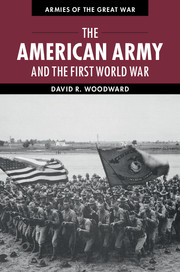Book contents
- Frontmatter
- Dedication
- Contents
- List of figures
- List of maps
- List of tables
- Preface
- List of abbreviations
- Introduction
- 1 Birth of a modern army
- 2 World war and American preparedness
- 3 Coercive power and Wilsonian diplomacy
- 4 “You’re in the army now”
- 5 US army doctrine and industrialized trench warfare
- 6 Over where?
- 7 American Expeditionary Force organization, overseas training, and deployment
- 8 Will the Americans arrive in time?
- 9 Failed expectations: “the military establishment of the United States has fallen down”
- 10 Atlantic ferry
- 11 Neck of the bottle
- 12 Uncertain times
- 13 Cantigny
- 14 Into the breach
- 15 American soldiers in north Russia and Siberia
- 16 The beginning of the end
- 17 Establishment of the American First Army and Saint-Mihiel
- 18 Meuse-Argonne, September 26–October 31
- 19 Breakout, November 1–11
- 20 Epilogue
- Notes
- Bibliography
- Index
1 - Birth of a modern army
Published online by Cambridge University Press: 05 July 2014
- Frontmatter
- Dedication
- Contents
- List of figures
- List of maps
- List of tables
- Preface
- List of abbreviations
- Introduction
- 1 Birth of a modern army
- 2 World war and American preparedness
- 3 Coercive power and Wilsonian diplomacy
- 4 “You’re in the army now”
- 5 US army doctrine and industrialized trench warfare
- 6 Over where?
- 7 American Expeditionary Force organization, overseas training, and deployment
- 8 Will the Americans arrive in time?
- 9 Failed expectations: “the military establishment of the United States has fallen down”
- 10 Atlantic ferry
- 11 Neck of the bottle
- 12 Uncertain times
- 13 Cantigny
- 14 Into the breach
- 15 American soldiers in north Russia and Siberia
- 16 The beginning of the end
- 17 Establishment of the American First Army and Saint-Mihiel
- 18 Meuse-Argonne, September 26–October 31
- 19 Breakout, November 1–11
- 20 Epilogue
- Notes
- Bibliography
- Index
Summary
On the evening of February 15, 1898, Captain Charles D. Sigsbee, the commander of the second-class battleship USS Maine, dispatched a shocking report to the Secretary of the Navy. His modern warship had been ordered earlier from Key West to Havana to protect US citizens from the turbulence of an insurgency against Spanish rule in Cuba. At 9:40 p.m. a tremendous explosion in the stern had rocked his warship which quickly sank to the bottom. This explosion killed 266 members of his crew.
What had happened? “The loss of this magnificent battleship is the most remarkable known to naval history,” editorialized the Milwaukee Journal. “Ships have floundered, burned, been wrecked, and in many ways destroyed; but it remained for a vessel of the best type to be blown up and burned in a peaceful harbor. It is difficult to imagine, in the absence of full information, how the accident occurred.” A US Naval enquiry concluded that the explosion had been caused by a mine but did not attempt to fix blame. (Careful enquiries following the Spanish–American War suggested that the explosion had been caused by a spontaneous combustion in one of the Maine’s coal bunkers which ignited the forward magazines.)
- Type
- Chapter
- Information
- The American Army and the First World War , pp. 4 - 16Publisher: Cambridge University PressPrint publication year: 2014

